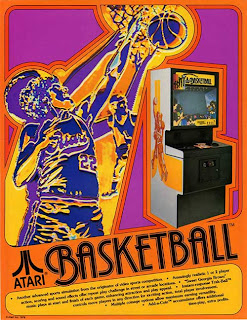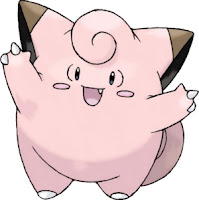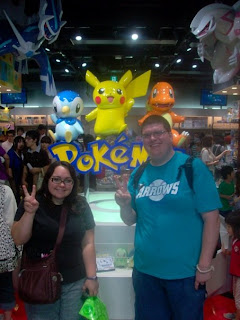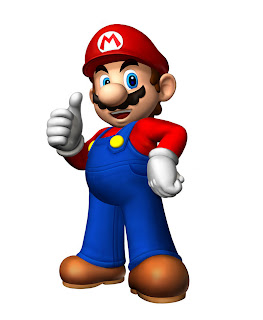This is a new feature I will be trying on the web site. I will mostly be doing the history of a video game character, but may put a system or game history out once in a while. For the character histories my sections will be history, where I tell about the history of the character, Appearances and Storylines, where I tell about the storylines of their video game sereis, and Games, where I list the games that the character has been in. I explain the cameo appearances.
Mario got his trademark look due to the graphical limitations of the video games of that era. He has a red shirt and blue overalls because it was easy to distinguish between those colors and the background. He was given a hat because Miyamoto did not want to have to worry about his hair style and animating it when he jumped. He also has a big nose and moustache so that they did not have to animate a mouth and all of the facial expressions.
Miyamato never expected Mario to become as popular as he did. He expected him to be around a long time, but only to be used as cameos. He wanted a character that could be used for any instance. Also, Nintendo has never revealed Mario's full name. Many have declared that it is Mario Mario because of the title of the series being called "The Mario Brothers." The full name has only been used in The Super Mario Bros. Movie and Prima's official Strategy Guide to Mario and Luigi: Superstar Saga.
Later on, Princess Toadstool is captured and he must go across the eight worlds of the Mushroom Kingdom and defeat the ruler of the castle and frees the Mushroom Retainer. On his next adventure Mario gets the help of Luigi, Toad, and Princess Peach to defeat Wart with vegetables. This involved going through the characters dreamworld called Subcon. After they get back from Subcon, Peach is again captured by Bowser and Mario and Luigi must save her. This time they have to fight through Bowser's seven children, Lemmy, Iggy, Roy, Morton Jr., Ludwig, Larry, and Wendy, before they finally reach Bowser.
In Super Mario Land, Mario must again save a princess. This time it is Princess Daisy of Sarasaland. She is being captured by the evil alien Tatanga. In Super Mario World it is decided that Mario, Luigi, and Peach are in need of some rest and relaxation, so they head to Dinosaur Land for a vacation. While they are there, Peach is again kidnapped, and Mario and Luigi must go and save her. They meet a dinosaur named Yoshi, who becomes there friend, and must battle Bowser's seven children again. In Super Mario Land 2: Six Golden Coins a new antagonist of the Mario series is introduced. In this game, Wario puts an evil spell over the inhabitants of Mario Land and he renames it Wario Land while Mario is in Sarasaland during the first Super Mario Land game. Wario did this so that he could get Mario's castle because he wanted one of his own. Mario must find the six golden coins and take back his land. The next game, Super Mario World 2: Yoshi's Island, is a prequel to the rest of the series. In this game you learn that the stork that brought Mario and Luigi to their parents was attacked by Kamek and he steals Baby Luigi. Mario falls onto Yoshi Island and with the help of the Yoshi's he rescues Luigi.
Mario then made his 3D debut with the release of the Nintendo 64 and Super Mario 64. In this game Peach sends Mario a letter asking him to share a cake with her. Mario arrives at her castle and finds out that Princess Peach was kidnapped by Bowser (surprise, surprise). Instead of a world map, Mario goes to the different levels by jumping through the paintings in the castle. Unlike the other Mario games, Mario faces Bowser multiple times. He must defeat Bowser three times at different points during the game.
 |
| Super Mario Sunshine |
In Super Mario Sunshine, Mario, Toadsworth, and Princess Peach go on a vacation to Isle Delfino. They soon find out that the area is being vandalized by a Mario lookalike known as Shadow Mario. Mario is blamed for the vandalism and upon his arrival to the island is promptly arrested by the authorities. His punishment is community service and he is ordered to clean up the island. He is given a Flash Liquidizer Ultra Dousing Machine, also known as FLUDD. This was invented by Professor E. Gadd and is used to clean up the island and collect shine sprites. Shadow Mario eventually kidnaps Peach and reveals himself to be Bowser Jr., Bowser's eighth child.
In Super Mario Galaxy, Mario is invited to the centennial Star Festival by Princess Peach. When Mario arrives, Bowser lifts Peach's castle off of its foundation and hurls it into outer space. Failing to protect Peach, Mario meets starlike creatures called Lumas and their caretaker, Rosalina. Rosalina tells Mario that Bowser has stolen the power stars and he has taken Peach to the center of the Universe. Mario then travels to different galaxies to get the power stars and save Princess Peach. In Mario's most recent game, Super Mario Galaxy 2, Bowser turns himself into a giant with the power stars and kidnaps Princess Peach and takes her to the center of the universe again. With the help of the Lumas, Mario pilots the Starship Mario, a planet in the shape of Mario's head, to travel to various galaxies and collect power stars to fuel the ship. He eventually arrives at Bowser's lair and defeats him for the eighth time (not counting the New Super Mario Bros. series.)
Besides helping protect the Mushroom Kingdom from Bowser Mario likes to race go-karts, play tennis, golf, play soccer, play baseball, paint, and various other activities. Some of those activities he even lets Bowser and his minions join in on the fun.
Games: Mario has appeared in 163 Games!
1981-Donkey Kong (Arcade)
1982-Donkey Kong Jr. (Arcade)
1983-Mario's Cement Factory (Game and Watch)
1983-Mario's Bombs Away (Game and Watch)
1983-Pinball (Arcade), Mario and Pauline show up in the bonus stage
1983-Mario Bros. (Arcade)
1984-Mario Bros. Special (NEC PC-8801)
1984-Punch Ball Mario Bros. (NEC PC-8801)
1984-Donkey Kong Hockey (Game and Watch), Mario plays against Donkey Kong
1984-F1 Race (NES), Mario appears at the end of a race circuit
1985-Tennis (NES), Mario is the referee
1985-Baseball (NES), Mario is the pitcher for one of the teams
1985-Super Mario Bros. (NES)
1985-Wrecking Crew (NES)
1985-Golf (NES, Mario is the golfer
1986-Super Mario Bros. Special (NEC PC-8801)
1986-Super Mario Bros. 2 (Famicom Disk System)
1986-All Night Nipon Super Mario Bros. (Famicom Disk System)
1987-Famicom Grand Prix: F1 Race (Famicom Disk System), Mario is the Player 1 racer
1987-Mario Bros. II (Commodore 64)
1987-Punch-Out!! (NES), Mario is the referee
1988-Super Mario Bros. 2 (NES)
1988-Famicom Grand Prix II: 3D Hot Rally (Famicom Disk System), Mario is the driver
1988-Super Mario Bros. 3 (NES)
1988-I am a Teacher: Super Mario Sweater (Famicom Disk System)
1989-Tetris (NES), Mario appears during the game end screen
1989-Alleyway (Game Boy), Levels modeled after Mario's head and body
1989-Super Mario Land (Game Boy)
1990-Dr. Mario (NES)
1990-Qix (Game Boy), Mario is seen during a cutscene
1990-Super Mario World (SNES)
1991-NES Open Tournament Golf (NES), Mario is the first player golfer
1991-Mario Teaches Typing (PC)
1991-Super Mario Bros. and Friends: When I Grow Up (PC)
1991-Mario the Juggler (Game and Watch)
1991-Yoshi (Game Boy)
1992-Mario is Missing! (SNES)
1992-Supe Mario Kart (SNES)
1992-Super Scope 6 (SNES), Mario appears in a mini game
1992-Mario Paint (SNES)
1992-Yoshi's Cookie (NES)
1992-Super Mario Land 2: 6 Golden Coins (Game Boy)
1992-The Legend of Zelda: A Link to the Past (SNES), Mario appears in some pictures
1993-Mario's Time Machine (SNES)
1993-Mario and Wario (SNES)
1993-Super Mario All Stars (SNES)
1993-Mario's Early Years: Fun with Letters (SNES)
1993-Mario's Early Years: Fun with Numbers (SNES)
1993-Mario's Early Years: Preschool Fun (SNES)
1993-Yoshi's Safari (SNES)
1994-Wario Land: Super Mario Land 3 (Game Boy)
1994-Mario's Playschool (PC)
1994-Hotel Mario (CD-i)
1995-Donkey Kong Country 2: Diddy Kong's Quest (SNES), Mario appears in first or second place
1995-Super Mario World 2: Yoshi's Island (SNES)
1995-Mario's Game Gallery (PC)
1995-Undake 30 Same Game (Satellaview), Mario's head appears as an icon
1995-Mario Excite Bike (Satellaview)
1995-BS Super Mario USA Powr Challenge (Satellaview)
1995-Mario's Picross (Game Boy)
1995-Mario's Super Picross (SNES)
1995-Mario's Tennis (Virtual Boy)
1995-Mario Clash (Virtual Boy)
1996-Mario Teaches Typing 2 (PC)
1996-Super Mario 64 (N64)
1996-Mario Kart 64 (N64)
1996-Super Mario RPG: Legend of the Seven Stars (SNES)
1996-Kirby Super Star (SNES), Mario is in the crowd
1997-BS Mario Paint: Yuu Shou Naizou Ban (Satellaview)
1997-Game and Watch Gallery (Game Boy), Appears in mini games
1997-Game and Watch Gallery 2 (Game Boy), Appears in mini games
1998-Mario no Photopi (N64)
1998-Wrecking Crew '98 (Satellaview)
1998-Super Mario Bros. Deluxe (Game Boy Color)
1998-Mario Golf (N64)
1998-Mario Party (N64)
1998-The Legend of Zelda: Ocarina of Time (N64), Mario appears in a picture
1999-Mario Party 2 (N64)
1999-Super Smash Bros. (N64)
1999-Game and Watch Gallery 3 (Game Boy Color)
1999-Mario Artist: Paint Studio (N64 DD)
1999-Donkey Kong 64 (N64), Unlock original Donkey Kong arcade game
2000-Mario Artist: Talent Studio (N64 DD)
2000-Mario Artist: Communication Kit (N64 DD)
2000-Mario Artist: Polygon Studio (N64 DD)
2000-Mario Tennis (N64)
2000-Paper Mario (N64)
2000-Mario Party 3 (N64)
2000-The Legend of Zelda: Majora's Mask (N64), Mario's face is one of the masks
2001-Animal Crossing (Gamecube), You can buy a Mario statue
2001-Dr. Mario 64 (N64)
2001-Luigi's Mansion (Gamecube), Mario is kidnapped
2001-Super Smash Bros. Melee (Gamecube)
2001-Mario Kart: Super Circuit (Game Boy Advance)
2001-Super Mario Advance (Game Boy Advance)
2001-Super Mario Advance 2: Super Mario World (Game Boy Advance)
2002-Super Mario Sunshine (Gamecube)
2002-Mario Party 4 (Gamecube)
2002-Yoshi's Island: Super Mario Advance 3 (Game Boy Advance)
2002-Game and Watch Gallery 4 (Game Boy Advance)
2003-Mario Party 5 (Gamecube)
2003-Mario Kart: Double Dash (Gamecube)
2003-Mario Golf: Toadstool Tour (Gamecube)
2003-Nintendo Puzzle Collection (Gamecube)
2003-Super Mario Advance 4: Super Mario Bros. 3 (Game Boy Advance)
2003-Mario and Luigi: Superstar Saga (Game Boy Advance)
2004-Paper Mario: The Thousand Year Door (Gamecube)
2004-Mario Party 6 (Gamecube)
2004-Mario Power Tennis (Gamecube)
2004-Mario vs. Donkey Kong (Game Boy Advance)
2004-Mario Golf: Advance Tour (Game Boy Advance)
2004-Mario Pinball Land (Game Boy Advance)
2004-Super Mario 64 DS (DS)
2004-Yakuman DS (DS), Mario is a playable character
2004-Metal Gear Solid: The Twin Snakes (Gamecube), Mario appears as a toy on a computer
2005-NBA Street V3 (Gamecube), Mario is a playable character
2005-Mario Superstar Baseball (Gamecube)
2005-Dance Dance Revolution Mario Mix (Gamecube)
2005-SSX on Tour (Gamecube), Mario is a playable character
2005-Mario Kart DS (DS)
2005-Mario Party 7 (Gamecube)
2005-Super Mario Strikers (Gamecube)
2005-Mario and Luigi: Partners in Time (DS)
2005-Yoshi's Touch and Go (DS)
2005-Mario Party Advance (Game Boy Advance)
2005-Mario Tennis: Power Tour (Game Boy Advance)
2005-Mario Kart Arcade GP (Arcade)
2006-Super Princess Peach (DS)
2006-New Super Mario Bros. (DS)
2006-Mario Hoops 3-on-3 (DS)
2006-Mario vs. Donkey Kong 2: March of the Minis (DS)
2006-Yoshi's Island DS (DS)
2006-Tetris DS (DS), Mario is in the backdrops
2007-Super Paper Mario (Wii)
2007-Mario Party 8 (Wii)
2007-Mario Strikers Charged (Wii)
2007-Mario and Sonic at the Olympic Games (Wii)
2007-Super Mario Galaxy (Wii)
2007-Mario Party DS (DS)
2007-Itadeki Street DS (DS), Mario is a playable character
2007-Mario Kart Arcade GP 2 (Arcade)
2008-Super Smash Bros. Brawl (Wii)
2008-Dr. Mario Express (DSi)
2008-Dr. Mario Online RX (Wii)
2008-Mario Kart Wii (Wii)
2008-Mario Super Sluggers (Wii)
2008-Mario Power Tennis (Wii)
2009-Mario and Sonic at the Winter Olympic Games (Wii)
2009-New Super Mario Bros. Wii (Wii)
2009-Mario and Luigi: Bowser's Inside Story (DS)
2010-Super Mario Galaxy 2 (Wii)
2010-Mario vs. Donkey Kong Mini-Land Mayham (DS)
2010-Mario Sports Mix (Wii)
2011-Super Mario 3D Land (3DS)
2011-Mario and Sonic at the London 2012 Olympic Games (Wii)
2011-Mario Kart 7 (3DS)
2011-Fortune Street (Wii), Mario is a playable character
2012-Mario Party 9 (Wii)
2012-Mario Tennis Open (3DS)
2012-New Super Mario Bros. 2 (3DS)
2012-Paper Mario: Sticker Star (3DS)
2012-New Super Mario Bros. U (Wii U)
2012-Nintendo Land (Wii U)











-1.png)























-screenshot.jpg)

